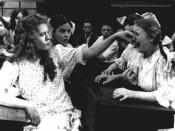ABC's of Bullying
Bullying may seem an insignificant issue when compared to drug abuse or guns being brought into schools. However, what compels students to believe they need to bring a weapon to school? Bullying comes in many shapes and forms. Being the last picked for a team, excluded from a party, pushed in the hallway, or teased are just a few examples of bullying. Parents, teachers, and students hear it, see it, but how to intervene and prevent bullying is the big question. What do teachers and parents let slide or put a stop to? When peers see bullying, do they get involved? What if the bully turns their attention onto them as a new victim? Or if they report the incident to an adult, run the risk of being labeled as a tattle-tail? From an adult's perspective, how can they punish what they do not see? "Sticks and stones may break my bones, but words will never hurt me," is how the old motto goes, however, words hurt most of all.
No bones may be broken, yet a child's broken spirit can be considerably worse.
What Is Bullying?
A top researcher of bullying in school-age children, Dan Olweus, defines bullying as:
"A student is being bullied or victimized when he or she is exposed, repeatedly and over time, to negative actions on the part of one or more other students."
Olweus has done extensive studies in Norway over the past 20 years and found that approximately 15 per cent, or one in seven students, are involved in victim/bully
problems. Within these same studies, about 9 per cent are victims, and 7 per cent bully others on a regular basis. A child who is tougher, more daring, and more confident than normal, tend to bully other children who...


